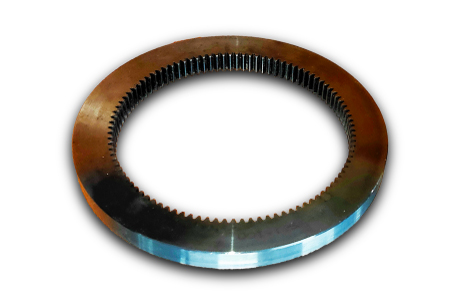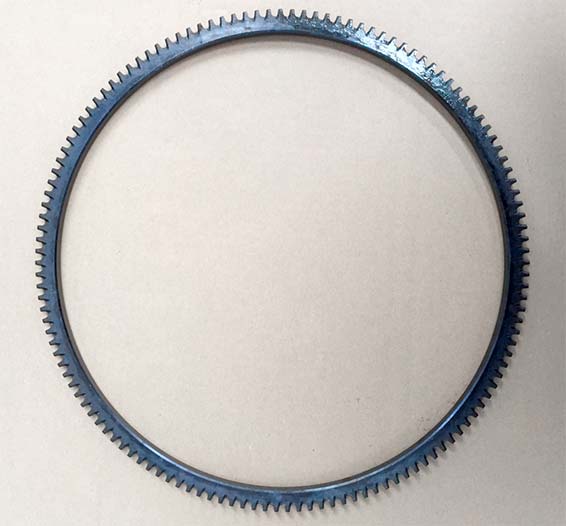Product Description
Key attributes
Other attributes
Applicable Industries
Manufacturing Plant, Machinery Repair Shops, Energy & Mining
Weight (KG)
1650
Showroom Location
None
Video outgoing-inspection
Provided
Machinery Test Report
Provided
Marketing Type
Hot Product 2571
Warranty of core components
1 Year
Core Components
Gear
Place of CHINAMFG
ZheJiang , China
Condition
New
Warranty
1.5 years
Shape
Ring Gear
Standard or Nonstandard
Nonstandard
Tooth Profile
Spur
Material
Steel
Processing
Casting
Pressure Angle
20°
Brand Name
HangZhou
Product Name
custom large diameter alloy steel spur casting large ring gear
Application
Cement kiln
Gear Machining
Gear milling
Module of Gear:
8-120
OD For Gear Wheel:
MAX.13 000 mm
Height For CHINAMFG
MAX. 1200 mm
Certificate
ISO 9001:2015
Tolerance
+/-0.01mm
Heat treatment
QT
Surface Treatment
Surface Hardening or Carburizing and Quenching
Packaging and delivery
Packaging Details
Package for Cement kiln custom large diameter ring gear transmission alloy steel spur casting large ring gear is wooden box and adapts to CHINAMFG transport
Port
ZheJiang ,HangZhou or Others
Supply Ability
Supply Ability
9000 Ton/Tons per Year
OUR WORKSHOPS
OUR EQUIPMENTS
Technology Process
|
Material |
Carbon steel,Alloy steel |
||
|
Structure |
Forging,casting |
||
|
Type of gear |
spur gear,helical gear,Planetary Gear |
||
|
Heat treatment |
Quenching and tempering |
||
|
Process |
forging, rough machining, QT, finish machining |
||
|
Main equipments |
hobbing,CNC machine |
||
|
Module |
up to 200 |
||
|
Precision of gear |
Grinding ISO Grade 5-7 & Hobbing ISO Grade 8-9 |
||
|
Inspection |
Raw material inspection, UT,physical property test,dimension inspect |
||
|
Application |
Mining machinery, mill, kiln and other equipment |
||
OUR CERTIFICATE
OUR CUSTOMER FEEDBACK
CONTACT
/* January 22, 2571 19:08:37 */!function(){function s(e,r){var a,o={};try{e&&e.split(“,”).forEach(function(e,t){e&&(a=e.match(/(.*?):(.*)$/))&&1
| Application: | Industry |
|---|---|
| Hardness: | Hb190-Hb300 |
| Gear Position: | External Gear |
| Samples: |
US$ 100/Piece
1 Piece(Min.Order) | Order Sample |
|---|
| Customization: |
Available
| Customized Request |
|---|
.shipping-cost-tm .tm-status-off{background: none;padding:0;color: #1470cc}
| Shipping Cost:
Estimated freight per unit. |
about shipping cost and estimated delivery time. |
|---|
| Payment Method: |
|
|---|---|
|
Initial Payment Full Payment |
| Currency: | US$ |
|---|
| Return&refunds: | You can apply for a refund up to 30 days after receipt of the products. |
|---|

What lubrication is required for ring gears?
Proper lubrication is essential for the optimal performance and longevity of ring gears. Here’s a detailed explanation of the lubrication requirements for ring gears:
- Type of Lubricant: The type of lubricant used for ring gears depends on various factors, including the application, operating conditions, and gear design. Common lubricants for ring gears include gear oils, grease, and synthetic lubricants. Gear oils are specifically formulated for gear systems and provide excellent lubrication and protection against wear. Grease is often used in applications where the gear system operates at lower speeds or requires higher viscosity lubrication. Synthetic lubricants offer enhanced performance, durability, and resistance to extreme temperatures and loads.
- Lubricant Properties: The lubricant chosen for ring gears should possess certain properties to ensure effective lubrication. These properties include high film strength, good thermal stability, resistance to oxidation, and anti-wear characteristics. The lubricant should also be compatible with the materials used in the ring gear system to prevent damage or degradation of the gear surfaces.
- Viscosity: Viscosity is an important consideration when selecting lubrication for ring gears. Viscosity refers to the thickness or resistance to flow of the lubricant. It is crucial to choose a lubricant with the appropriate viscosity to ensure proper lubrication film formation between the gear teeth. If the lubricant’s viscosity is too low, it may not provide sufficient lubrication, leading to increased wear. Conversely, if the viscosity is too high, it may cause excessive friction and energy loss. The recommended viscosity range is typically specified by the gear manufacturer or industry standards.
- Lubrication Method: The lubrication method for ring gears can vary depending on the specific application and gear system design. For enclosed gear systems, such as gearboxes or sealed housings, lubrication is typically performed by filling the housing with the recommended lubricant to the appropriate level. In open gear systems, such as large industrial gears, lubricant application methods may include spray systems, drip lubrication, or circulation systems. The lubrication method should ensure sufficient coverage and distribution of the lubricant to all gear surfaces.
- Lubrication Frequency: Regular lubrication maintenance is crucial to keep ring gears properly lubricated. The frequency of lubrication depends on the operating conditions, gear system design, and the lubricant used. It is important to follow the manufacturer’s recommendations or industry standards regarding lubrication intervals. Regular inspections should also be conducted to monitor the lubricant condition, check for contamination, and replenish or replace the lubricant as needed.
- Environmental Considerations: Environmental factors, such as temperature, moisture, and contamination, can affect the performance of the lubricant and the ring gears. It is important to consider these factors when selecting the lubricant. Extreme temperatures may require lubricants with enhanced thermal stability, while exposure to moisture or harsh contaminants may necessitate lubricants with better resistance to corrosion or water washout.
To ensure the proper lubrication of ring gears, it is advisable to consult the gear manufacturer’s recommendations and guidelines. They can provide specific information regarding the suitable lubricant type, viscosity range, lubrication method, and maintenance practices for the particular ring gear system.

How do you maintain and service a ring gear system?
Maintaining and servicing a ring gear system is crucial to ensure its optimal performance, reliability, and longevity. Here’s a detailed explanation of the maintenance and service procedures for a ring gear system:
- Regular Inspections: Conduct regular inspections of the ring gear system to detect any signs of wear, damage, misalignment, or abnormal conditions. Inspect the gear teeth for chips, cracks, or excessive wear. Check for proper gear engagement and backlash. Inspect the mounting bolts or fasteners for tightness. Regular inspections help identify potential issues early on and prevent further damage or failures.
- Cleaning and Lubrication: Clean the ring gear system periodically to remove dirt, debris, and old lubricant. Use appropriate cleaning methods and solvents that are compatible with the gear system materials. After cleaning, apply fresh lubricant according to the manufacturer’s recommendations. Ensure proper lubrication coverage and distribution to minimize friction, wear, and heat generation.
- Lubricant Analysis: Periodically analyze the condition of the lubricant in the ring gear system to assess its effectiveness and detect any contamination or degradation. Lubricant analysis involves collecting samples and sending them to a laboratory for testing. The analysis results can provide valuable information about the lubricant’s viscosity, contamination levels, and overall condition. Based on the analysis, determine whether lubricant replacement or additional maintenance actions are necessary.
- Bearing and Seal Inspection: If the ring gear system includes bearings or seals, inspect them regularly for wear, damage, or leaks. Check for excessive play, noise, or overheating in the bearings. Inspect the seals for proper sealing and lubricant retention. Replace any worn-out bearings or damaged seals to prevent further damage to the ring gear system.
- Torque Checks: Periodically check the torque of the mounting bolts or fasteners that secure the ring gear system. Over time, vibrations and operational stresses can cause bolts to loosen. Ensure that the bolts are tightened to the manufacturer’s recommended torque specifications. Perform torque checks during scheduled maintenance intervals or when any signs of loosening are observed.
- Alignment and Gear Meshing: Check and adjust the alignment of the ring gear system if necessary. Misalignment can lead to uneven wear, increased load on the gear teeth, and reduced performance. Ensure proper gear meshing and backlash according to the manufacturer’s specifications. Adjust the gear positioning or contact pattern if deemed necessary during inspections or maintenance activities.
- Repair or Replacement: If any significant damage, wear, or malfunction is identified during inspections or maintenance activities, plan for repair or replacement of the affected components. Depending on the severity and nature of the issue, repairs may involve repairing gear teeth, replacing damaged parts, or realigning the gear system. If extensive damage is present or the gear system has reached the end of its service life, consider replacing the entire ring gear system.
- Documentation and Record-Keeping: Maintain detailed documentation and records of all maintenance and service activities performed on the ring gear system. Keep track of inspection results, lubrication schedules, repairs, parts replacements, and any other relevant information. These records help establish a maintenance history, track performance trends, and provide valuable reference information for future maintenance and troubleshooting.
It’s important to note that the specific maintenance and service procedures may vary depending on the type of ring gear system, its application, and the manufacturer’s guidelines. Always refer to the manufacturer’s recommendations and consult with experts or professionals when necessary to ensure proper maintenance and servicing of the ring gear system.

What industries commonly use ring gears?
Ring gears, also known as annular gears or internal gears, are utilized in various industries due to their unique characteristics and capabilities. Here’s a detailed explanation of the industries that commonly use ring gears:
- Automotive Industry: Ring gears are extensively used in the automotive industry. They are a crucial component in automotive transmissions, differential systems, and steering mechanisms. Ring gears help transmit torque and rotational motion, enabling smooth shifting of gears and efficient power transfer in vehicles.
- Aerospace Industry: The aerospace industry relies on ring gears for various applications. They are used in aircraft engines, landing gear systems, actuation mechanisms, and aerospace gearboxes. Ring gears provide reliable and precise motion control in critical aerospace systems.
- Industrial Machinery: Ring gears find wide applications in industrial machinery, including heavy machinery, manufacturing equipment, and power generation systems. They are used in gearboxes, speed reducers, and other power transmission systems. Ring gears enable efficient torque transfer and motion control in industrial settings.
- Robotics: Ring gears play a significant role in robotics and automation. They are employed in robotic joints, manipulator arms, and motion control systems. Ring gears provide precise and smooth rotation, allowing robots to perform intricate tasks with accuracy and repeatability.
- Power Generation: Ring gears are utilized in power generation equipment such as wind turbines, hydroelectric generators, and steam turbines. They are part of the gearbox systems that convert the rotational motion of the turbine blades into electrical energy. Ring gears enable efficient power transmission and adaptability to varying load conditions.
- Heavy Equipment and Construction: The heavy equipment and construction industry extensively use ring gears in equipment like excavators, cranes, loaders, and bulldozers. They are vital for the operation of the drivetrain and hydraulic systems, enabling controlled movement and power transfer in demanding construction environments.
- Marine Industry: Ring gears are employed in various marine applications, including ship propulsion systems, marine winches, and steering mechanisms. They provide reliable torque transfer and motion control in marine vessels, ensuring efficient navigation and maneuverability.
- Renewable Energy: Ring gears are utilized in renewable energy systems such as solar tracking systems and tidal power generation. They enable the precise tracking of solar panels and the efficient conversion of tidal forces into electrical energy.
The diverse applications of ring gears across these industries highlight their versatility and importance in various mechanical systems. The specific design, size, and material selection of ring gears may vary depending on the industry requirements and operating conditions.


editor by Dream 2024-04-29